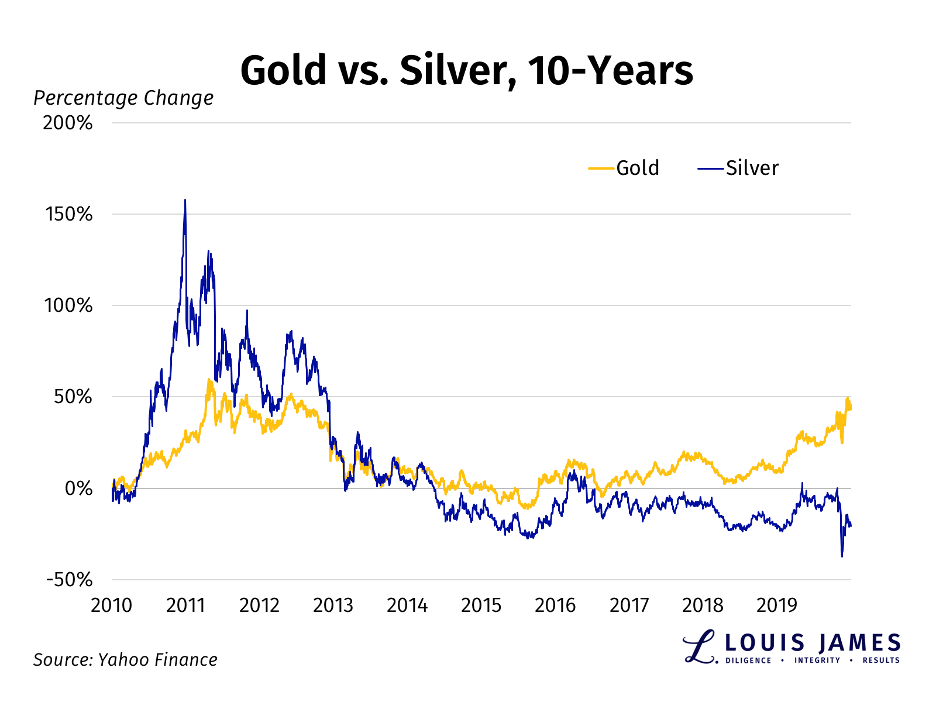There’s been a lot of what I see as fearmongering regarding silver. Some say it’s become just another industrial metal. The record gold-silver ratios we’re seeing are offered as evidence of this. I don’t agree.
I understand that central banks buying tonnes of gold every year—but no silver—says that the major players no longer see silver as a financial asset.
And I get that silver dropping about three times as much as gold in March—all the way down to $12—seemed like shocking proof of its demise.
The 10-year gold vs. silver chart shows that silver has fallen and just can’t seem to get up.

But I think rumors of silver’s death will prove to be much exaggerated.
Here’s why:
- Silver has always been more volatile than gold. The March meltdown was no exception. The correlation between the directional moves of the two metals remains very high.
- Silver rallied about 34.5% last year at the same time gold broke out, rising 21.6% (but with a lag on the larger gains). There was no silver shortage at the time, and no explosion of industrial demand. Silver simply moved with gold—exactly as a monetary metal should.
- Central banks may not care about silver, but billions of people around the world still see it as money. Silver is the word for money in many languages. Many people who live in countries with long histories of debasing their currencies and who can’t afford gold coins save in silver.
- It’s not just poor people who care about silver. Investment demand in rich countries has gone through the roof. There’s still a massive shortage of silver bullion products on the market. Premiums remain ridiculously high. This seems likely to take months to clear up, and the scarcity should bolster the market.
- The industrial demand shock we saw in March is real. China uses huge amounts of silver making solar panels, as just one of many industrial applications the metal has. So of course China’s COVID-19 shutdown caused a major buyer to disappear from the marketplace. This is already being reversed. Reduced demand doesn’t mean zero demand.
- At the same time, COVID-19 shutdowns have already taken a large chunk of this year’s silver production off the table, as Peru, Mexico, and other places shuttered their mines. This too is starting to be reversed, but it will take time, Marginal players may not reopen even if allowed, due to the extra costs of operating under strict new health rules.
- Going forward, it’s even more important that the global recession (if not depression) underway is going to greatly reduce demand for and production of most industrial minerals. This includes the gigantic copper and other base-metal mines that produce most of the world’s silver as a byproduct.
- It was this sort of combination—rising safe-haven demand for monetary metals combined with expectations of reduced supply due to reduced industrial activity—that sent silver into one of its mini-manias after the Crash of 2008.
Please note that I’m not promising another mini-mania—but I do see that card in the deck.
And if gold ever did go back into circulation as cash, the need for silver coinage to make change would send silver prices soaring. The gold-silver ratio might not just return to 80 or 90, nor merely 50 or 60, but all the way back to 20 or so. Governments would start hoarding silver again.
But let’s set that happy dream aside for now.
As the world is today, reduced mine supply should do a lot to counter reduced industrial demand, enabling silver to rise with gold… even if at a greater distance.
Let’s say gold rises to $3,000, as Bank of America projected, and stays there. Let’s also say that the current gold-silver ratio increases from the current 114 (as I type) to 125. That would take silver prices to $24 per ounce—a price at which many of today’s silver miners would gush cash.
Even if the gold-silver ratio went to 150, that would still take silver to $20, a price that would greatly improve the bottom line for today’s producers.
And if the gold-silver ratio were to go back to its pre-Crash of 2008 range—let’s say 60—that would take silver over $50 per ounce. Silver bugs would be breaking out the Dom Perignon big time.
I can’t say which of these scenarios is the most likely.
I can say that the data show us that silver still moves with gold, and in all of these scenarios, this is very bullish for silver.
I expect we’ll see silver lag gold on the next leg up, as usual, but I still expect silver to end up delivering larger gains on a percentage basis by the time this market peaks.
That’s my take,
![]()
P.S. To be kept abreast of more dangers, opportunities, and issues affecting investors, please sign up for our free, no-spam, weekly Speculator’s Digest.

